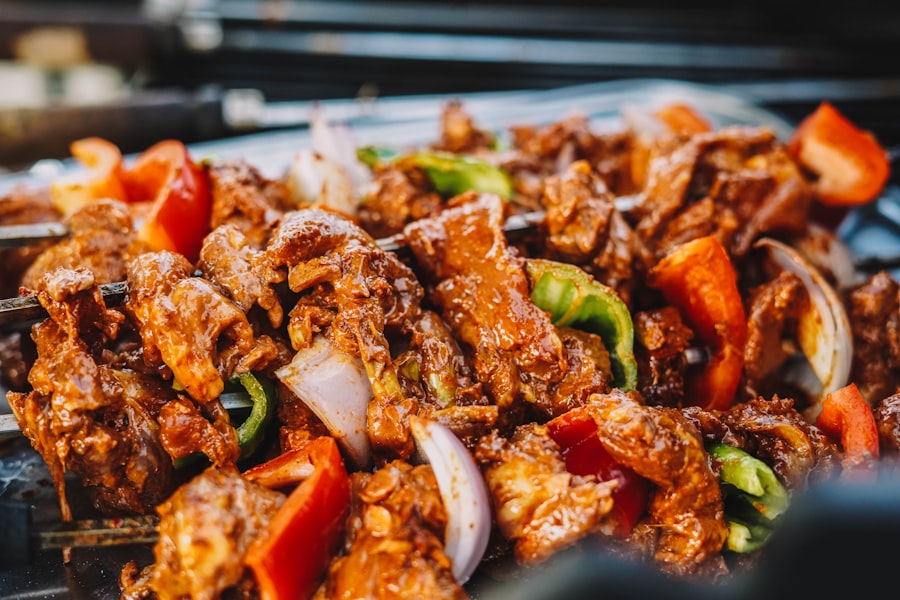Korean BBQ, also known as “gogi-gui,” is a popular Korean culinary tradition that involves grilling meat, typically at the table, and enjoying it with a variety of side dishes and condiments. The most common meats used in Korean BBQ are beef, pork, and chicken, which are often marinated in a flavorful mixture of soy sauce, sesame oil, garlic, and other seasonings. The grilling is usually done on a gas or charcoal grill built into the dining table, allowing diners to cook the meat to their preferred level of doneness.
The experience of Korean BBQ extends beyond the food itself, encompassing the social aspect of gathering around the grill, cooking and eating together, and enjoying the lively atmosphere. This unique and interactive dining experience has gained popularity worldwide, appealing to those who appreciate both delicious food and communal dining. The flavors of Korean BBQ are characterized by bold and savory notes, with a balance of sweet, salty, and umami tastes.
The side dishes, known as banchan, add variety in textures and flavors to the meal, contributing to a satisfying and memorable dining experience. These side dishes may include items such as kimchi, pickled vegetables, and various salads. Korean BBQ can be enjoyed at specialized restaurants or prepared at home.
Understanding the basics of Korean BBQ, including the types of meat, marinades, grilling techniques, and accompanying side dishes, is essential for creating an authentic experience. Whether dining out or hosting a BBQ party at home, Korean BBQ offers a unique culinary adventure that combines flavorful food with social interaction.
Key Takeaways
- Korean BBQ involves grilling marinated meats at the table, creating a fun and interactive dining experience.
- Choose high-quality cuts of meat like bulgogi (marinated beef) or samgyupsal (pork belly) for the best results.
- Perfect your grilling techniques by ensuring the grill is hot enough and flipping the meat at the right time for optimal flavor.
- Create a variety of banchan, or side dishes, such as kimchi, pickled vegetables, and seasoned seaweed, to complement the BBQ meats.
- Master the art of Korean BBQ sauce by experimenting with different combinations of soy sauce, sesame oil, garlic, and other flavorful ingredients.
Choosing the Right Meat and Marinades
Popular Meats for Korean BBQ
The most popular meats used in Korean BBQ are beef, pork, and chicken. For beef, cuts like bulgogi (thinly sliced marinated beef) and galbi (beef short ribs) are commonly used. Pork belly, thinly sliced pork shoulder, and pork ribs are popular choices for pork BBQ. Chicken thighs or breast can also be used for a lighter option.
The Importance of Meat Quality
It is essential to select high-quality cuts of meat with a good balance of lean meat and marbling for the best flavor and texture. This ensures that the meat is tender, juicy, and packed with flavor.
Marinating for Flavor and Tenderness
Marinating the meat is a crucial step in Korean BBQ that infuses the meat with flavor and tenderizes it for grilling. The marinade typically consists of soy sauce, sesame oil, garlic, sugar, and other seasonings like ginger or pear puree for sweetness and acidity. Each type of meat may have its own specific marinade recipe, but the basic components remain consistent. Marinating the meat for at least a few hours or overnight allows the flavors to penetrate the meat thoroughly, resulting in a more flavorful and tender end product.
Perfecting Your Grilling Techniques

Grilling the meat to perfection is an essential part of the Korean BBQ experience. Whether you are using a gas or charcoal grill built into the dining table or an outdoor grill, there are certain techniques to keep in mind to ensure that the meat is cooked just right. It is important to preheat the grill to a high temperature before adding the meat to achieve a nice sear and caramelization on the surface.
For thinly sliced meats like bulgogi or pork belly, it is best to cook them quickly over high heat to prevent them from becoming tough. Thicker cuts like galbi or pork ribs may require longer cooking times over lower heat to ensure that they are cooked through without burning on the outside. Another important aspect of perfecting your grilling techniques is knowing when the meat is done.
Overcooking the meat can result in dry and tough texture, while undercooking can pose health risks. Using a meat thermometer can help you gauge the doneness of the meat accurately. For beef, medium-rare to medium is often preferred for a tender and juicy texture.
Pork should be cooked through to ensure food safety, while chicken should reach an internal temperature of 165°F (74°C). Perfecting your grilling techniques will ensure that the meat is cooked to perfection, resulting in a delicious and satisfying Korean BBQ experience.
Creating the Perfect Banchan (Side Dishes)
| Side Dish | Ingredients | Preparation Time |
|---|---|---|
| Kimchi | Cabbage, Radish, Red Pepper Flakes, Garlic, Fish Sauce | 1-2 days |
| Soybean Sprouts | Soybean Sprouts, Garlic, Green Onion, Soy Sauce, Sesame Oil | 15 minutes |
| Spinach | Spinach, Soy Sauce, Sesame Oil, Garlic, Sesame Seeds | 10 minutes |
| Cucumber Salad | Cucumber, Red Pepper Flakes, Garlic, Vinegar, Sugar | 10 minutes |
In addition to the grilled meat, Korean BBQ is also known for its wide array of banchan, or side dishes, that accompany the meal. Banchan can range from simple pickled vegetables and kimchi to more elaborate dishes like japchae (stir-fried glass noodles) and bindaetteok (mung bean pancakes). The variety of banchan adds different flavors, textures, and colors to the meal, creating a well-rounded dining experience.
When creating the perfect banchan spread for your Korean BBQ meal, it is important to consider a balance of flavors and textures to complement the grilled meat. Some popular banchan dishes include kimchi (fermented spicy cabbage), kongnamul (seasoned soybean sprouts), oi muchim (spicy cucumber salad), and gamja jorim (braised potatoes). These dishes provide a mix of spicy, savory, sweet, and tangy flavors that pair well with the rich and savory grilled meats.
It is also important to consider a variety of textures, from crunchy pickled vegetables to soft and chewy rice cakes or pancakes. Creating a diverse and well-balanced banchan spread will elevate your Korean BBQ experience and provide a satisfying accompaniment to the grilled meats.
Mastering the Art of Korean BBQ Sauce
Korean BBQ sauce, also known as ssamjang or dipping sauce, is an essential component of the Korean BBQ experience. Ssamjang is a thick, savory paste made from fermented soybean paste (doenjang), chili paste (gochujang), sesame oil, garlic, and other seasonings. It is often used as a dipping sauce for grilled meats or as a condiment for wrapping grilled meat in lettuce or perilla leaves.
The combination of savory, spicy, and nutty flavors in ssamjang adds depth and richness to the grilled meats, enhancing their natural flavors. In addition to ssamjang, there are other types of Korean BBQ sauces that can be used to add flavor to the grilled meats. Bulgogi sauce is a sweet and savory marinade made from soy sauce, sugar, sesame oil, garlic, and pear puree that is commonly used for marinating beef bulgogi.
Galbi sauce is another popular marinade made from soy sauce, sugar, sesame oil, garlic, and fruit puree that is used for marinating beef short ribs. These sauces add layers of flavor to the meats and contribute to the overall deliciousness of the Korean BBQ experience. Mastering the art of Korean BBQ sauce will allow you to create an authentic and flavorful dining experience that will impress your guests.
Tips for Hosting a Korean BBQ Party

Preparation is Key
Marinating the meats ahead of time allows them to absorb maximum flavor before grilling. Setting up a designated grilling area with a gas or charcoal grill creates an interactive dining experience for your guests.
Variety is the Spice of Life
Offering a range of meats and banchan caters to different tastes and dietary preferences. Options like beef bulgogi, pork belly, chicken thighs, and an assortment of banchan ensure there’s something for everyone to enjoy.
Creating a Festive Atmosphere
Creating a welcoming atmosphere with music, decorations, and table settings that reflect the spirit of Korean dining culture is crucial. Encouraging guests to participate in grilling their own meats and wrapping them in lettuce or perilla leaves with ssamjang adds an interactive element to the dining experience. By following these tips, you’ll host a successful Korean BBQ party that your guests will cherish.
Embracing the Korean BBQ Experience
Embracing the Korean BBQ experience goes beyond just enjoying delicious food; it involves immersing yourself in the communal spirit of sharing a meal with others. Whether you are dining at a Korean BBQ restaurant or hosting a BBQ party at home, embracing the Korean BBQ experience means savoring each bite of perfectly grilled meat alongside an array of flavorful banchan dishes. It means engaging in lively conversation with friends and family while taking turns grilling meats at the table.
Embracing the Korean BBQ experience also means appreciating the rich culinary traditions and flavors that have been passed down through generations in Korean culture. It means understanding the significance of each dish and condiment on the table and savoring them with respect for their origins. It means embracing the interactive nature of grilling meats at the table and enjoying the process as much as the end result.
Ultimately, embracing the Korean BBQ experience is about creating lasting memories with loved ones over a shared meal that brings joy and satisfaction to all who partake in it.
If you’re a fan of Korean grill, you might also be interested in learning about the benefits of drinking living water. Check out this article to discover how living water can improve your health and well-being.
FAQs
What is a Korean grill?
A Korean grill, also known as a Korean barbecue, is a style of grilling meat, typically beef, pork, or chicken, at the table. It is a popular dining experience in Korean cuisine where diners cook their own meat on a grill built into the table.
What type of meats are typically grilled at a Korean grill?
At a Korean grill, a variety of meats are typically grilled, including thinly sliced beef (such as bulgogi), pork belly (samgyeopsal), and marinated chicken.
What are some popular side dishes served at a Korean grill?
Popular side dishes served at a Korean grill include kimchi (fermented vegetables), pickled radishes, lettuce leaves for wrapping the grilled meat, and various dipping sauces.
What type of grill is used at a Korean grill restaurant?
Korean grill restaurants typically use a charcoal or gas grill built into the dining table, allowing diners to cook their own meat to their preferred level of doneness.
What is the traditional way of eating at a Korean grill?
The traditional way of eating at a Korean grill involves grilling the meat at the table, then wrapping it in lettuce leaves along with various side dishes and sauces to create a small, flavorful package. This is then eaten in one bite.



